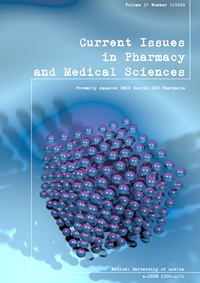Quantification of chlorogenic acid in Pluchea indica L. stem ethanolic extracts and its antioxidant activity
DOI:
https://doi.org/10.2478/cipms-2024-0006Keywords:
Beluntas, chlorogenic acid, DPPH, ultrasonic-assisted extraction, sequential extractionAbstract
Chlorogenic acid (CA) is an important phenolic acid antioxidant. It is found in Pluchea indica L. (Asteraceae). However, it has only been extensively studied in the leaves, while studies on the stems have not been reported. This study aimed to identify and measure the levels of CA in the stem extract of P. indica. The extract was also determined for its antioxidant activities. In the course of the work, P. indica stems powder was extracted using the ultrasonic-assisted extraction (UAE) technique employing 50% ethanol as solvent directly and sequentially. The extract was then measured for total phenolic content (TPC) and CA content using RP-HPLC. Meanwhile, antioxidant activities were determined by the DPPH, ABTS, and reducing power (RP) methods. TPC in the sequential and the direct of P. indica stems ethanol extracts were 1.4694±0.0228 and 1.9314±0.0318 mgGAE/g DW, respectively. We found that the CA content of 50% ethanol extract of P. indica stems from sequential extraction (0.2045±0.0128 %, w/w) was higher than 50% ethanol extract from direct extraction (0.1984±0.0113%, w/w). The two extracts demonstrated good antioxidant capacity, while the ethyl acetate and n-hexane extracts did not. Identifying of other antioxidants phenolics using other extracting methods still needs further study.
References
1. Naveed M, Hejazi V, Abbas M, Kamboh AA, Khan GJ, Shumzaid M, et al. Chlorogenic acid (CGA): A pharmacological review and call for further research.Biomed Pharmacother.2018;97:67-74.
2. Kritsi E, Tsiaka T, Ioannou AG, Mantanika V, Strati IF, Panderi I, et al.In Vitroandin silicostudies to assess edible flowers’ antioxidant activities.Appl Sci.2022;12(14):7331.
3. Lu H, Tian Z, Cui Y, Liu Z, Ma X. Chlorogenic acid: A comprehensive review of the dietary sources, processing effects, bioavailability, beneficial properties, mechanisms of action, and future directions.Compr Rev Food Sci Food Saf.2020;1-29.
4. Wianowska D, Gil M. Recent advances in extraction and analysis procedures of natural chlorogenic acids.Phytochem Rev.2019;18(1): 273-302.
5. Arsiningtyas IS, Gunawan-Puteri MDPT, Kato E, Kawabata J. Identification of α-glucosidase inhibitors from the leaves ofPluchea indica(L.) Less., a traditional Indonesian herb: promotion of natural product use.Nat Prod Res.2014;28(17):1350-3.
6. Kongkiatpaiboon S, Chewchinda S, Vongsak B. Optimization of extraction method and HPLC analysis of six caffeoylquinic acids in Pluchea indica leaves from different provenances in Thailand.Rev Bras Farmacogn.2018;28(2):145-50.
7. Vongsak B, Kongkiatpaiboon S, Jaisamut S, Konsap K. Comparison of active constituents, antioxidant capacity, and α-glucosidase inhibition inPluchea indicaleaf extracts at different maturity stages. Vol. 25,Food Bioscience.2018. p. 68-73.
8. Chewchida S, Vongsak B. Simultaneous HPTLC quantification of three caffeoylquinic acids inPluchea indicaleaves and their commercial products in Thailand.Rev Bras Farmacogn.2019;29: 177-81.
9. Normala H, Suhaimi MI. Quantification of total phenolics in different parts ofPluchea indica(Less) ethanolic and water extracts.Pertanika J Sci Technol.2011;19(1):19-24.
10. Shaikh JR, Patil M. Qualitative tests for preliminary phytochemical screening: An overview.Int J Chem Stud. 2020;8(2):603-8.
11. Hikmawanti NPE, Hanani E, Sapitri Y, Ningrum W. Total phenolic content and antioxidant activity of different extracts ofCordia sebestenaL. Leaves.Pharmacogn J.2020;12(6):1311-6.
12. Molyneux P. The Use of the stable free radical diphenylpicrylhydrazyl (DPPH) for estimating antioxidant activity.Songklanakarin J Sci Technol.2004;26(2):211-9.
13. Khatua S, Ghosh S, Acharya K. Simplified methods for microtiter based analysis of in vitro antioxidant activity.Asian J Pharm.2017; 11(2):S327-35.
14. Dewick PM.Medicinal natural products: A Biosynthetic Approach.John Wiley & Sons, Ltd; 2002:1-539.
15. Liu W, Li J, Zhang X, Zu Y, Yang Y, Liu W, et al. Current advances in naturally occurring caffeoylquinic acids: Structure, bioactivity, and synthesis.J Agric Food Chem.2020;68(39):10489-516.
16. Zhang QW, Lin LG, Ye WC. Techniques for extraction and isolation of natural products: A comprehensive review.Chin Med.2018;13(20).
17. Dai J, Mumper RJ. Plant phenolics: Extraction, analysis and their antioxidant and anticancer properties.Molecules. 2010;15:7313-52.
18. Upadhyay R, Mohan Rao LJ. An outlook on chlorogenic acids-occurrence, chemistry, technology, and biological activities.Crit Rev Food Sci Nutr.2013;53(9):968-84.
19. Huang D, Wong IC. Antioxidant evaluation and antioxidant activity mechanisms. In: Logan A, Nienaber U, Pan X (ed).Lipid oxidation: Challenges in food systems. Academic Press and AOCS Press; 2013:323-43.
20. Alam MN, Bristi NJNJ, Rafiquzzaman M. Review onin vivoandin vitromethods evaluation of antioxidant activity.Saudi Pharm J. 2013;21(2):143-52.
21. Tirzitis G, Bartosz G. Determination of antiradical and antioxidant activity: basic principles and new insights.Acta Biochim Pol.2010; 57(1):139-42.
22. Gulcin İ. Antioxidants and antioxidant methods: an updated overview.Arch Toxicol.2020;94(3):651-715.
23. Wang T, Hicks KB, Moreau R. Antioxidant activity of phytosterols, oryzanol, and other phytosterol conjugates.JAOCS.2002;79(12): 1201-6.
24. Munteanu IG, Apetrei C. Analytical methods used in determining antioxidant activity: A review.Int J Mol Sci.2021;22(7).
Downloads
Published
Issue
Section
License
Copyright (c) 2024 Authors

This work is licensed under a Creative Commons Attribution-NonCommercial-NoDerivatives 3.0 Unported License.


